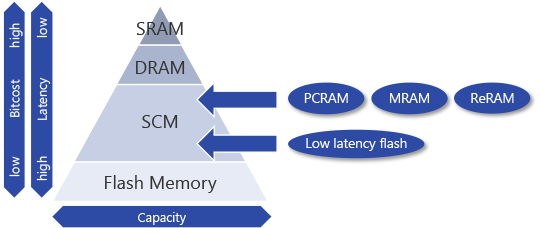Please select your location and preferred language where available.
Demonstration of Database Performance Comparison using XL-FLASH™ aiming at DRAM Replacement
October 28, 2020
With the development of 5G networks and so on, the more data is generated explosively, and the data is stored in storage as a database for CPU to process in various applications such as machine learning and AI. In current computing system, data transfer and exchange occurs from the storage to the main memory in order to process the data by CPU. However, there is large performance gap between DRAM as main memory and SSD as storage and it causes inefficiency of data processing. Therefore, in order to reduce data movement, it is required to expand the main memory and also reduce access latency to the storage (Fig. 1).

The solution to this problem is to introduce SCM (Storage Class Memory) as a new layer in the memory hierarchy. SCM fills the latency and capacity gap between DRAM and flash memory. There has been active research in novel memory of SCM (Fig. 2). We have announced low latency flash memory XL-FLASH™ as SCM. The read latency of XL-FLASH™ is 5μs, which is extremely fast compared to conventional flash memory (Table I).

Table. I Feature comparison table between XL-FLASH™ and conventional flash memory
|
XL-FLASH™[1] |
Conventional[2] |
|
|---|---|---|
|
Read latency |
<5μs |
58μs |
|
Capacity |
128Gbits |
512Gbits |
|
Page size |
4KB |
16KB |
We demonstrate capability of replacing DRAM for a key-value store database using XL-FLASH™, which has lower bit cost and larger capacity than DRAM. There are two important factors when designing key-value store database for XL-FLASH™. 1) An efficient data transfer interface. 2) Data placement optimized for flash based SCM.
We have developed an interface that reduces the command overhead of the NVM Express™ protocol that is commonly used in high-performance SSDs for an efficient data transfer interface, and we have created a prototype of database that allocates infrequently accessed data to XL-FLASH™.
In order to evaluate the possibility of DRAM replacement using XL-FLASH™, we have developed XL-FLASH™ demo drive (Fig. 3), and demonstrated the evaluation result that the database using DRAM and the database using XL-FLASH™ have equivalent performance in read access-dominated situation (Fig. 4). This result shows that XL-FLASH™ has the potential to solve the problems of computing systems for database applications toward data explosion era.

|
Host Interface |
PCIe®*2Gen3, 4lanes |
|---|---|
|
# of flash memory |
XL-FLASH™ |
|
Capacity |
1TB |
|
256Byte random read |
8M IOPS*3 |
|
Drive read latency |
10μs |

This achievement was presented in the International Memory Workshop 2020(IMW 2020) as an invited keynote[3].
- NVM Express is a trademark of NVM Express Inc.
- PCIe is a registered trademark of PCI-SIG.
Any other company names, product names, and service names may be trademarks of their respective companies. - IOPS: Input Output Per Second
[1] Kioxia press release, August 5, 2019
http://americas.kioxia.com/en-us/business/news/2019/memory-20190805-1.html
[2] H. Maejima et al., “A 512Gb 3b/Cell 3D Flash Memory on a 96-Word-Line-Layer Technology”, IEEE International Solid-State Circuits Conference, ISSCC 2018, pp. 336-338
[3] T. Shiozawa, K. Hiwada, H. Kajihara, and T. Endo, “Emerging Usage and Evaluation of Low Latency FLASH,” IEEE International Memory Workshop, IMW 2020, pp. 8-11
This material is a partial excerpt and a reconstruction of the reference [3] © 2020 IEEE.

